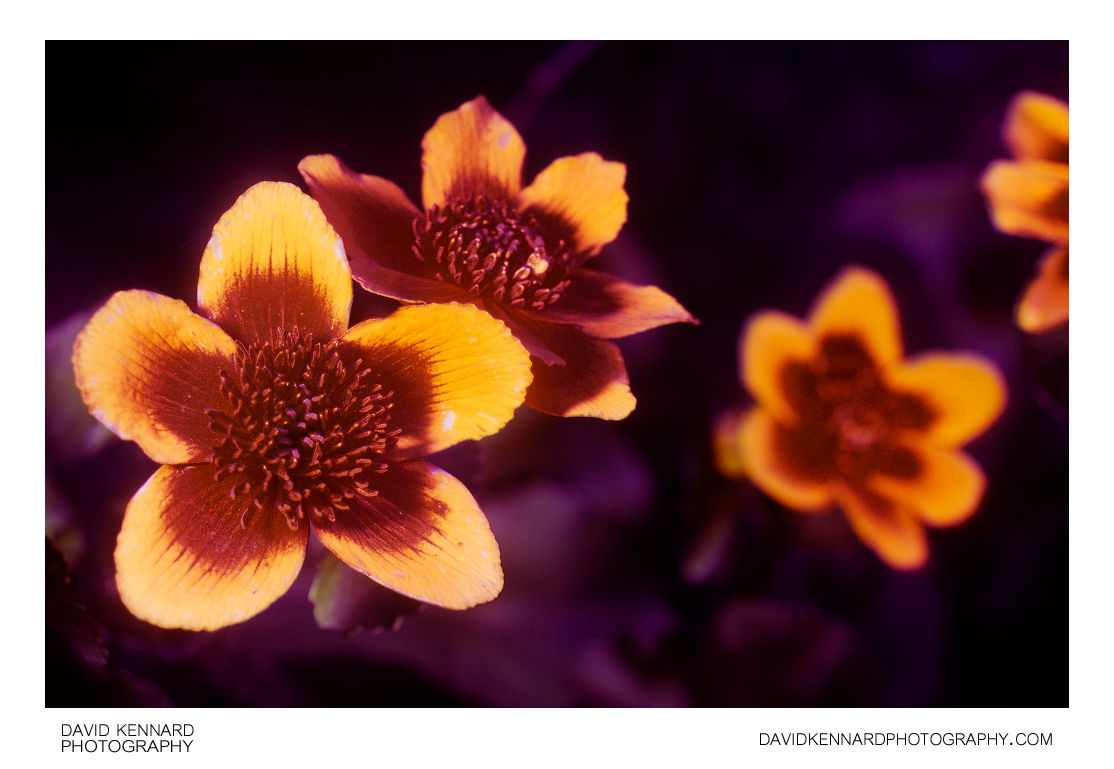Marsh Marigold (Caltha palustris) UV + Vis

Description
- Title:
- Marsh Marigold (Caltha palustris) UV + Vis
- Caption / Description:
-
Combined Ultraviolet and visible light photo of Marsh Marigold flowers in Spring. The flowers appear plain yellow to the human eye, which cannot see ultraviolet light. Under ultraviolet light a clear 'hidden' pattern can be seen, with the centre of the flower being dark while the edges of the petals are bright.
Many insects can see in ultraviolet light, it is believed that the ultraviolet markings on some flowers, such as the Marsh Marigold, help guide insects to the centre of the flower where the pollen and nectar reside.
Caltha palustris (kingcup, marsh marigold) is a perennial herbaceous plant of the family Ranunculaceae, native to marshes, fens, ditches and wet woodland in temperate regions of the Northern Hemisphere.
It becomes most luxuriant in partial shade, but is rare on peat. In the United Kingdom, it is probably one of the most ancient native plants, surviving the glaciations and flourishing after the last retreat of the ice, in a landscape inundated with glacial meltwaters.
Description adapted from Wikipedia: http://en.wikipedia.org/wiki/Caltha_palustris
- Tags / Keywords:
-
- Biota
- Life
- Vitae
- Eukaryota
- Plantae
- Plants
- Magnoliophyta
- Flowering Plants
- Angiosperms
- Magnoliopsida
- Dicotyledons
- Buttercups
- Ranunculales
- Ranunculaceae
- Caltha
- Marsh Marigolds
- Caltha palustris
- Kingcup
- Yellow Marsh Marigold
- Ultraviolet
- UV
Admin
- Date Original Photo Taken:
- Original File Name:
- _DIR0026, 28, 29.psd
- Event:
- Rating:
- ☆
- Date this image added/last updated on website:
- Original File Dimensions:
- 4182px x 2729px
- File Type:
- JPEG
- Color Mode:
- Original Image Color Profile:
- Adobe RGB (1998)
Location
- Location Created:
-
- Sublocation:
- City:
- Market Harborough
- Province/State:
- Leicestershire
- Country:
- United Kingdom
- World Region:
- Europe
- Geo-location:
Rights
- Copyright Status:
- Copyrighted
- Licensing Status:
- Rights Managed
- Available for Editorial Use:
- Yes
- Available for Commercial Use:
- Yes
- Copyright Notice:
- © 2013 Dave Kennard
Camera Data
- Date Digital Resource was created:
- Shutter speed:
- 1⁄160 s
- Aperture:
- f/5.6
- Camera Model:
- Fujifilm IS Pro
- ISO:
- 800
- Exposure Compensation:
- 1
- Focal Length:
- 80mm
- Focal Length (35mm equiv.):
- 126mm
- Metering Mode:
- Center-weighted average
- Flash:
- Off, Did not fire
- Exposure Mode:
- Manual
- White Balance:
- Manual
- Light Source:
- Unknown
- Exposure Program:
- Manual
Additional shooting metadata
- Lens:
- Nikon EL-Nikkor 80mm F5.6
- Filters used:
-
- B+W 486 UV IR Cut MRC
- Baader U
- Additional Optics used:
-
- Kenko DG Extension Tubes 20mm
- 17mm-31mm M42 Focusing helicoid
- Setup:
- Tripod, Geared head, focusing rail.
For UV image: 2x full spectrum Vivitar 283 flash guns triggered by radio trigger used for lighting the flower. Another full spectrum Vivitar 283 mounted on gorillapod used for fill on the background flowers. Silver reflector placed behind flowers to bounce some of the light back and provide tiny bit more fill.
For visible light image natural light was used.
Post Processing
- Image Modified:
- Software used:
-
- Adobe Camera RAW
- Adobe Photoshop CS5
- Post Processing:
Visible light image in multiply blend mode over UV image. Curves adjusted.
